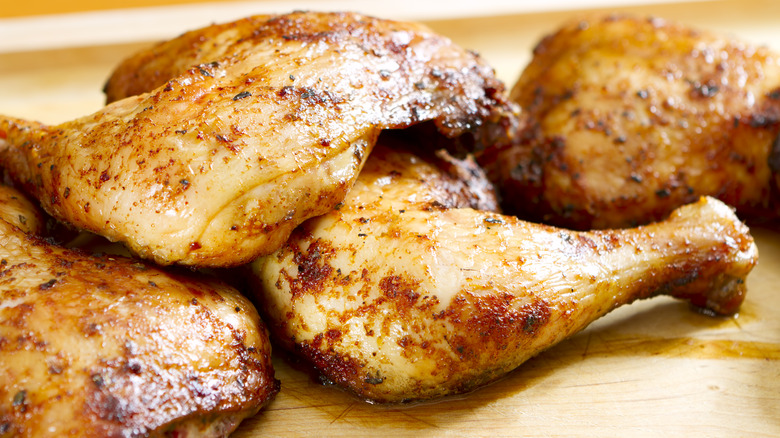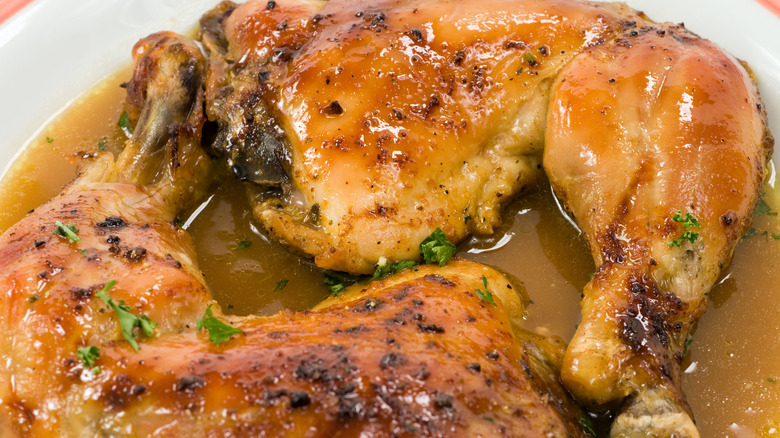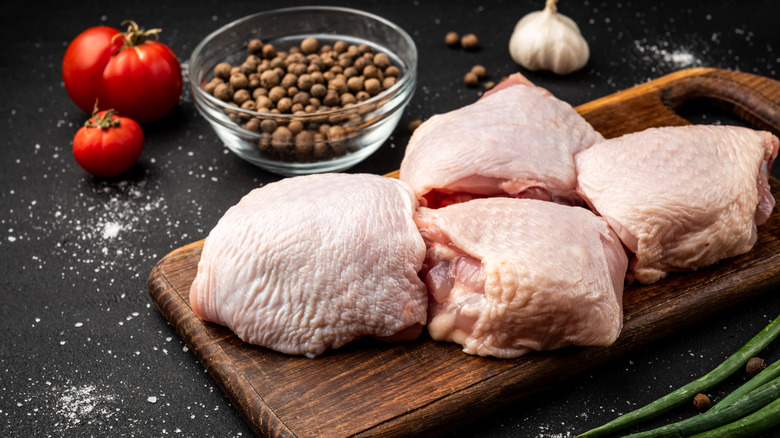The Easy Way To Ensure Your Chicken Thighs Are As Crispy As Possible
What makes a good chicken thigh? Some say it's the seasoning you use, while others say it's how you cook them. While these factors can play into what makes a chicken thigh delicious, we're focusing on the skin's crispiness. Granted, we don't mean making it like a piece of Kentucky Fried Chicken but spotting crispy, golden skin on a chicken thigh is a surefire sign that you're about to be eating well.
So, how can you get the crispiest skin on your chicken thigh? There are a lot of tricks for making crispy chicken skin, ranging from overnight soaks in brine to baths in baking powder or beaten eggs. For a simple, no-hassle method that requires only basic motor skills, consider focusing on the skin itself. Before the chicken thighs go in the oven, air fryer, or onto the grill, you should work on stretching and smoothing the skin across each piece of chicken first. If you notice your chicken thigh has wrinkled skin, carefully pull it taut like you're trying to get a fitted sheet over your mattress.
Aside from giving a new meaning to playing with your food, what does stretching and smoothing the skin on your chicken thighs accomplish? The answer lies in how heat focuses on the skin rather than the meat inside.
Stretching out chicken skin keeps the meat from drying out
Picture this: You're digging into some chicken thighs. They look and smell good, so you have no reason to suspect they won't be delicious. However, upon taking the first bite, you discover that, somehow, the meat on the inside is dried out and tough while the skin is rubbery and chewy. What could have happened? Unfortunately, whoever cooked the thighs probably didn't stretch the skin out first.
Stretching and smoothing out the skin on your chicken thighs accomplishes two things: It protects the meat inside and exposes the skin to as much surface area heat as possible. Leaving your chicken skin uneven and scrunched up means it won't only be unevenly cooked, with some parts becoming browned and others cooking in their own grease, but it will also expose the meat to the oven's extreme heat. When you stretch out chicken skin, it can better absorb the heat — a key component in allowing it to crisp up — while the interior remains tender and juicy.
If your chicken thighs still don't come out the way you hoped even after smoothing out the skin, you may need to add something extra to the skin to make sure they have the chance to get as crispy as possible.
Rub salt on chicken skin before cooking the thighs
Anyone who has eaten a soft pretzel can tell you that salt dehydrates. While you may shy away from using excess salt in your food, you do need some to achieve the crispiest chicken skins possible.
Before you put your chicken thighs in the oven or fryer, give them a generous rub down with some salt. This includes covering the entire surface and slipping your hand underneath the skin to be thorough and get the best possible results. Not only does adding salt infuse more flavor into the chicken thighs, but it also works to eliminate any moisture from the skin. Excess water or moisture on chicken skin will boil and evaporate while it cooks, resulting in a flabby texture you probably don't want. When chicken skins are drier — and seasoned properly — they will naturally crisp up in the heat.
Of course, the trick here is not to oversalt your chicken, lest you end up with a leathery, salty piece of meat. Fortunately, you don't need much salt for this to work. A light but generous salt coating worked into the skin will still have noticeable results. Feel free to add any other spices you want during this process, as seasoning is essential to making any dish flavorful and delicious.


